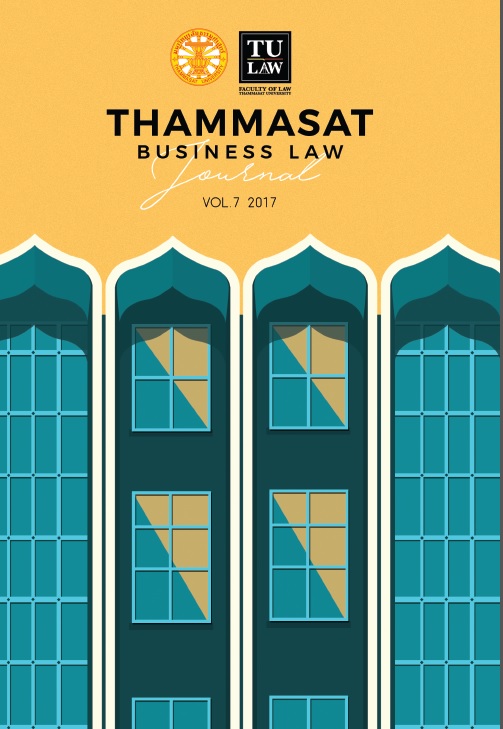A COMPARATIVE STUDY OF LEGAL MEASURES ON MEAT SAFETY IN THAILAND, THE UNITED STATES, AND SINGAPORE
Main Article Content
Abstract
Meat safety control in Thailand has been faced with complexities in regards to producer’s capacity and limitations, consumer’s demand and food culture, and requirements by international food regulations. In an attempt to seek for appropriate measures to cope with such complexities, a problem-based comparative analysis was conducted on legal measures on meat safety of three countries; namely, Thailand, the United States, and Singapore. Implications for improvements of Thai laws and regulations were derived respectively, focusing on domestic supply chain of raw meat, from primary production to slaughter.
Overall, the legal measures for meat safety of the U.S. and Singapore share the similar structure in that both countries regulate comprehensive as well as specific laws addressing the meat safety control. Moreover, they are based on the same concept that adulterated meat shall be strictly prevented from entering to the human consumption chain, and thus a holistic approach is essential throughout the meat supply chain. In details, however, the two countries place different emphases on legal measures in the aspects of allocation of authority, scope of laws, and the cooperation among concerned agencies. As for Thailand, remarkable efforts in advancing laws and regulations on meat safety have been noted in recent years. Nonetheless, there remains some room for improvements, particularly with regards to quality control for general domestic consumers. Foremost is the problem of the legal structure itself, in that laws governing meat safety are fragmented as several specific laws have been enacted, resulting in problematic implementations of regulations along the meat supply chain. On details, problems of the existing provisions were identified. In accordance with the findings, enhancement of provisions under the existing laws governing primary production and slaughter was proposed so that to handle problematic issues at hand. For the benefit in the long run, re-structuring of the meat safety laws governing the entire meat supply chain was also proposed under appropriate circumstances.
Article Details
References
Agri-food & Veterinary Authority of Singapore (AVA), “Legislation.”
http://www.ava.gov.sg/legislation. (accessed December 13, 2015).
Agri-food & Veterinary Authority of Singapore (AVA), “Wholesome Meat and Fish Act.” http://www.ava.gov.sg/docs/default-source/legislation/wholesome-meat-and-fish-act/60web_wmf_processing. (accessed December 13, 2016).
Bureau of Food Safety Extension and Support (BFSES, Thailand), “Chain of Actions on Food Safety.” http://www.foodsafety.moph.go.th/th/food-safety/general-detail. (accessed February 10, 2016).
Codex Alimentarius Commission (CAC), Code of Hygienic Practice for Meat (CAC/RCP 58-2005), Sec.3.
Commission of the European Communities, “White Paper on Food Safety.”
http://ec.europa.eu/dgs/health_food-safety/library/pub/pub06_en.pdf.
(accessed January 15, 2017).
Europe-ACP Liaison Committee (COLEACP), “EDES Handbook on Basic Food SafetyConcepts”. http://edes.coleacp.org/en/edes/page/20342-publications.
(accessed March 10, 2015).
European Commission, “Legislation.” https://ec.europa.eu/food/safety/biosafety/
food_hygiene/legislation_en. (accessed January 15, 2017).
Fortin, N.D. “Development of Food Legislation around the World: The United States and Canada”, Ensuring Global Food Safety: Exploring Global Harmonization, edited by Christine E. Boisrobert, et al, 32-36. New York, Elsevier, 2010.
Han, Y. “Food, Risk, and Changing Food Safety Control Systems: Politics of Food in Four Countries and the EU: A Comparative Perspective” (Ph.D. thesis, Nottingham Trent University, 2006).
Havas, K. and M. Salman. “Food Security: Its Components and Challenges.” Int. J. Food Safety, Nutrition and Public Health, 4(1), (2011).
James, L. and K. Wiedemann. “European Meat Inspection–Continuity and Change in Building a (more) Risk-Based System of Regulation.” European Food and Feed Law Review, 96, (2011).
Johnson, R. “Prescriptive Approaches to Food Safety in Meat Products.” Outlook on Agriculture, 33(3), (2004): 151-155.
Kantawanich, C., Meat Science Specialist, (Interview, January 15, 2015).
Leibovitch, E.H. “Food Safety Regulation in the European Union: Toward an Unavoidable Centralization of Regulatory Powers.” Texas International Law Journal, 43, (2008): 429-452.
McEvoy, J.D.G. “Emerging Food Safety Issues: An EU Perspective.” Drug Testing and Analysis, 8, (2016): 511-520.
National Bureau of Agricultural Commodity and Food Standards (ACFS, Thailand), “Roles of the ACFS Concerning with Codex’s Work)” http://www.acfs.go.th/codex/index.php. (accessed May 28, 2016).
Office of Agricultural Economics, Status and Trends of Significant Agricultural Commodities in 2015. (Ministry of Agriculture, Thailand, 2014).
Osothongs, M., Beef Production Specialist, (Interview, Apr 5, 2016).
Peerathornich T., Director of Bureau of Food Safety Extension and Support (BFSES,Thailand), (Interview, October 6, 2015).
Sofos, J.N. “Meat and Meat Product.” In Food Safety Management: A Practical Guide for the Food Industry, edited by Y. Motarjemi and H. Lelieveld, 119-158. New York: Elsevier, 2014.
Tai, S. “Whole Foods: The FSMA and the Challenges of Defragmenting Food
Safety Regulation.” American J. of Law & Medicine, 41, (2015): 447-458.
U.S. Codex Office, “U.S. Codex Strategic Plan (for 2012-2017)”
http://www.fsis.usda.gov/wps/wcm/connect/ab59575e-0ccc-4ff5-8ecb-300a0bbf5ffb/US_Codex_Strategic_Plan_2012-2017.pdf. (accessed January 6, 2017).
U.S. Department of Agriculture (USDA), “Federal Meat Inspection Act”. https://www.fsis.usda.gov/wps/portal/fsis/topics/rulemaking/federal-meat-inspection act. (accessed February 20, 2016).
van de Meulen, BMJ, “International Food Law.” In Ensuring Global Food Safety: Exploring Global Harmonization, edited by C. E. Boisrobert, New York: Elsevier, 2010.
World Organization for Animal Health (OIE), “Animal Production Food Safety”.
www.oie.int/en/food-safety/achievements-to-date. (accessed January 12, 2017).
World Organization for Animal Health (OIE), “Guide to Good Farming Practices for Animal Production Food Safety” http://www.oie.int/fileadmin/Home/eng/Food_Safety/docs/pdf/3_Lang_Good_farming_practices.pdf. (accessed January 12, 2017).
World Organization for Animal Health (OIE), “Our Mission”. http://www.oie.int/en/about-us/our-missions. (accessed January 12, 2017).
World Organization for Animal Health (OIE), “Terrestrial Animal Health Code”. https://www.oie.int/doc/ged/d10905.pdf. (accessed January 12, 2017).
World Trade Organization (WTO), “The WTO and the FAO/WHO Codex Alimentarius”. https://www.wto.org/english/thewto_e/coher_e/
wto_codex_e.htm. (accessed February 15, 2015).
Yang, Y.T. and M. Swineburne. “New Produce Safety Regulations: Promises and Challenges.” Public Health Reports, 131, (2016): 754. 754-757.
Zhou, G. “The Regulatory Regime of Food Safety in China: A Systemic not Accidental Failure.” (Ph.D. thesis, The University of Adelaide, 2016).


